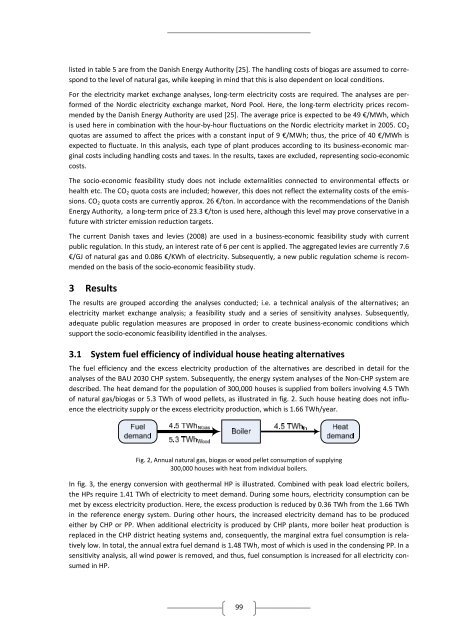Fuel cells and electrolysers in future energy systems - VBN
Fuel cells and electrolysers in future energy systems - VBN
Fuel cells and electrolysers in future energy systems - VBN
You also want an ePaper? Increase the reach of your titles
YUMPU automatically turns print PDFs into web optimized ePapers that Google loves.
listed <strong>in</strong> table 5 are from the Danish Energy Authority [25]. The h<strong>and</strong>l<strong>in</strong>g costs of biogas are assumed to corre‐<br />
spond to the level of natural gas, while keep<strong>in</strong>g <strong>in</strong> m<strong>in</strong>d that this is also dependent on local conditions.<br />
For the electricity market exchange analyses, long‐term electricity costs are required. The analyses are per‐<br />
formed of the Nordic electricity exchange market, Nord Pool. Here, the long‐term electricity prices recom‐<br />
mended by the Danish Energy Authority are used [25]. The average price is expected to be 49 €/MWh, which<br />
is used here <strong>in</strong> comb<strong>in</strong>ation with the hour‐by‐hour fluctuations on the Nordic electricity market <strong>in</strong> 2005. CO2<br />
quotas are assumed to affect the prices with a constant <strong>in</strong>put of 9 €/MWh; thus, the price of 40 €/MWh is<br />
expected to fluctuate. In this analysis, each type of plant produces accord<strong>in</strong>g to its bus<strong>in</strong>ess‐economic mar‐<br />
g<strong>in</strong>al costs <strong>in</strong>clud<strong>in</strong>g h<strong>and</strong>l<strong>in</strong>g costs <strong>and</strong> taxes. In the results, taxes are excluded, represent<strong>in</strong>g socio‐economic<br />
costs.<br />
The socio‐economic feasibility study does not <strong>in</strong>clude externalities connected to environmental effects or<br />
health etc. The CO2 quota costs are <strong>in</strong>cluded; however, this does not reflect the externality costs of the emis‐<br />
sions. CO2 quota costs are currently approx. 26 €/ton. In accordance with the recommendations of the Danish<br />
Energy Authority, a long‐term price of 23.3 €/ton is used here, although this level may prove conservative <strong>in</strong> a<br />
<strong>future</strong> with stricter emission reduction targets.<br />
The current Danish taxes <strong>and</strong> levies (2008) are used <strong>in</strong> a bus<strong>in</strong>ess‐economic feasibility study with current<br />
public regulation. In this study, an <strong>in</strong>terest rate of 6 per cent is applied. The aggregated levies are currently 7.6<br />
€/GJ of natural gas <strong>and</strong> 0.086 €/KWh of electricity. Subsequently, a new public regulation scheme is recom‐<br />
mended on the basis of the socio‐economic feasibility study.<br />
3 Results<br />
The results are grouped accord<strong>in</strong>g the analyses conducted; i.e. a technical analysis of the alternatives; an<br />
electricity market exchange analysis; a feasibility study <strong>and</strong> a series of sensitivity analyses. Subsequently,<br />
adequate public regulation measures are proposed <strong>in</strong> order to create bus<strong>in</strong>ess‐economic conditions which<br />
support the socio‐economic feasibility identified <strong>in</strong> the analyses.<br />
3.1 System fuel efficiency of <strong>in</strong>dividual house heat<strong>in</strong>g alternatives<br />
The fuel efficiency <strong>and</strong> the excess electricity production of the alternatives are described <strong>in</strong> detail for the<br />
analyses of the BAU 2030 CHP system. Subsequently, the <strong>energy</strong> system analyses of the Non‐CHP system are<br />
described. The heat dem<strong>and</strong> for the population of 300,000 houses is supplied from boilers <strong>in</strong>volv<strong>in</strong>g 4.5 TWh<br />
of natural gas/biogas or 5.3 TWh of wood pellets, as illustrated <strong>in</strong> fig. 2. Such house heat<strong>in</strong>g does not <strong>in</strong>flu‐<br />
ence the electricity supply or the excess electricity production, which is 1.66 TWh/year.<br />
Fig. 2, Annual natural gas, biogas or wood pellet consumption of supply<strong>in</strong>g<br />
300,000 houses with heat from <strong>in</strong>dividual boilers.<br />
In fig. 3, the <strong>energy</strong> conversion with geothermal HP is illustrated. Comb<strong>in</strong>ed with peak load electric boilers,<br />
the HPs require 1.41 TWh of electricity to meet dem<strong>and</strong>. Dur<strong>in</strong>g some hours, electricity consumption can be<br />
met by excess electricity production. Here, the excess production is reduced by 0.36 TWh from the 1.66 TWh<br />
<strong>in</strong> the reference <strong>energy</strong> system. Dur<strong>in</strong>g other hours, the <strong>in</strong>creased electricity dem<strong>and</strong> has to be produced<br />
either by CHP or PP. When additional electricity is produced by CHP plants, more boiler heat production is<br />
replaced <strong>in</strong> the CHP district heat<strong>in</strong>g <strong>systems</strong> <strong>and</strong>, consequently, the marg<strong>in</strong>al extra fuel consumption is rela‐<br />
tively low. In total, the annual extra fuel dem<strong>and</strong> is 1.48 TWh, most of which is used <strong>in</strong> the condens<strong>in</strong>g PP. In a<br />
sensitivity analysis, all w<strong>in</strong>d power is removed, <strong>and</strong> thus, fuel consumption is <strong>in</strong>creased for all electricity con‐<br />
sumed <strong>in</strong> HP.<br />
99

















